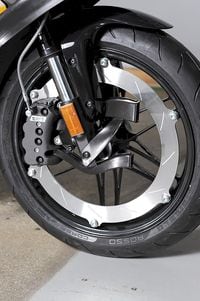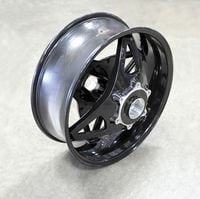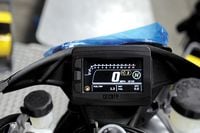The 1190RX chassis is a masterpiece of mass-centralization. The huge, cast-and-welded aluminum frame contains 4.5 gallons of premium unleaded in its massive twin spars, leaving lots of space for a high-volume airbox up above. The box-section aluminum swingarm pivots directly on the engine cases. Using a lattice design similar to the RS's, the RX's subframe is likewise cast from magnesium to save weight. Suspension components are sourced from Showa, the fork the latest big-piston design.
It's not a Rotax! Although it's based on the Helicon 1,125cc engine made for the former Buell Motorcycles, this much-altered powerplant is manufactured entirely by EBR. The oversquare, 1,190cc, 72-degree V-twin makes a claimed 185 hp and 101.6 pound-feet of torque. Midrange torque is augmented by staggered opening of the intake valves to create a swirl effect said to improve combustion efficiency and suppress detonation, also making a sky-high 13.4:1 compression ratio possible on pump gas.
A voluminous dual-chamber muffler resides under the engine, terminating in a single, matte-black silencer located on the right side of the bike. Twin midpipes serve separate functions—the lower tube acts as a quarter-wave resonator; the upper evacuates exhaust gases. Green-minded Erik Buell is especially proud of the tailpipe emissions: Hydrocarbon and NOx emissions are just 25 percent of what's allowable by the EPA, and CO2 is less than 6 percent—fairly remarkable figures for a big-bore superbike.
The front brake consists of a single, perimeter-mounted rotor acted on by an eight-piston caliper. The rim-mounted arrangement transmits braking force to the rim—not the hub—allowing a lightweight hubless wheel design. The front rim weighs just 7 pounds, and the entire assembly saves almost 10 pounds compared to a conventional dual-disc design, Buell says, reducing unsprung weight and contributing to light steering. The brake-cooling duct was fabricated from carbon fiber on the RS—it's plastic here.
There are no "hubs" separating the broad, triangular spiders on either side of the rear wheel—the axle passes directly through an open center. Finite element analysis (FEA) showed the hub wasn't important for wheel strength, so Buell simply cut it out, saving a significant amount of weight. The RX wheels are cast from aluminum instead of magnesium like they were on the RS, saving significant cost, too. How good are the production wheels? Good enough to be used on the WSBK racers.
The full-color TFT dash is made by a local supplier in Wisconsin and clearly presents all the relevant information, including speed, rpm (in digital bar-graph form), gear position, and traction control level (of 21 available selections, including off). The traction-control system, developed in-house by EBR in conjunction with the same Indiana-based firm that also supplies the ECU, monitors rear wheel speed, throttle position, and other unspecified vehicle dynamics to reduce wheelspin and maintain forward motion.
















/cloudfront-us-east-1.images.arcpublishing.com/octane/S35YGSEMEZB4BLTDJTSZPF4GLA.jpg)
/cloudfront-us-east-1.images.arcpublishing.com/octane/5UOT6HPX2JFMRJAX6EH45AR4MQ.jpg)
/cloudfront-us-east-1.images.arcpublishing.com/octane/OKWOJWAKP5EP3OACCRRWPCIX2Q.jpg)
/cloudfront-us-east-1.images.arcpublishing.com/octane/2WF3SCE3NFBQXLDNJM7KMXA45E.jpg)
/cloudfront-us-east-1.images.arcpublishing.com/octane/G4MG6OUCJNBSHIS2MVVOTPX65E.jpg)
/cloudfront-us-east-1.images.arcpublishing.com/octane/IIGGWFOTOJGB7DB6DGBXCCMTDY.jpg)
/cloudfront-us-east-1.images.arcpublishing.com/octane/QSTCM6AVEZA5JJBUXNIQ3DSOF4.jpg)
/cloudfront-us-east-1.images.arcpublishing.com/octane/U4I7G625B5DMLF2DVIJDFZVV6M.jpg)
/cloudfront-us-east-1.images.arcpublishing.com/octane/B6XD6LS6IVCQPIU6HXDJSM3FHY.jpg)
/cloudfront-us-east-1.images.arcpublishing.com/octane/ICL63FEDDRDTTMINYICCEYGMDA.jpg)
/cloudfront-us-east-1.images.arcpublishing.com/octane/FCGZHQXRBZFLBAPC5SDIQLVF4I.jpg)
/cloudfront-us-east-1.images.arcpublishing.com/octane/WNOB6LDOIFFHJKPSVIWDYUGOPM.jpg)

/cloudfront-us-east-1.images.arcpublishing.com/octane/X33NU3E525ECRHXLNUJN2FTRKI.jpg)
/cloudfront-us-east-1.images.arcpublishing.com/octane/6KKT5NNL2JAVBOXMZYS5ZO76YA.jpg)
/cloudfront-us-east-1.images.arcpublishing.com/octane/J5RKG5O455GMPGQRF2OG6LRT7A.jpg)
/cloudfront-us-east-1.images.arcpublishing.com/octane/GX2CIZKQVRH2TATDM26KFG2DAE.jpg)
/cloudfront-us-east-1.images.arcpublishing.com/octane/ZWIDYSAKQZHD5BHREMQILXJCGM.jpg)
/cloudfront-us-east-1.images.arcpublishing.com/octane/CYUHJZCTSJCH3MRAQEIKXK7SCQ.jpg)
/cloudfront-us-east-1.images.arcpublishing.com/octane/LKOFINY56FCXJCANJ5M7ZDQUBY.jpg)
/cloudfront-us-east-1.images.arcpublishing.com/octane/4NBPDACMWJH63JQYJVK3QRBDZI.jpg)
/cloudfront-us-east-1.images.arcpublishing.com/octane/KKHQHRR3FJGX7H2IPU6RALMWG4.jpg)

/cloudfront-us-east-1.images.arcpublishing.com/octane/5IOFS5JAE5FOXMNA23ZRAVVYUU.jpg)